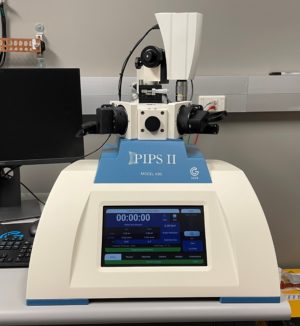
Precision Ion Polishing System II (Model 695)
The precision ion polishing system (Gatan PIPS™) II is an Ar+ ion mill system which provide thinning, polishing as well as cleaning for transmission electron microscope (TEM) sample preparation.
The PIPS II system is incorporated with the X, Y positioning stage for precise centering of the milling target with cold stage. It also includes a 10” touchscreen for ease of use and increased control and reproducibility of the milling process. The digital zoom microscope monitors the polishing process in real time, plus the color images can be stored in DigitalMicrograph® (DM) software for review and analysis while the sample is in the TEM.
Benefits
- WhisperLok with X, Y stage: Ability to center the region of interest for re-polish
- Low energy focusing penning ion guns: Improved low energy milling for focused ion beaam (FIB) prepared samples
- Variable energy from 0.1 – 8.0 kV: Improved low energy milling for reduction in amorphous layer for corrected TEMs
- LN2 specimen cooling: Eliminates artifacts
- 10” color touchscreen control: Simple but full control from the graphical user interface (GUI)
- Digital zoom microscope: Operates in real time while milling
- Color image storage in DM software: Ability to store and use optical images with the TEM and EELS data in the same format
Applications
- Semiconductor
- Metals (oxide, alloy)
- Ceramics
Specifications
Ion source
Ion guns Two penning ion guns with low energy focusing electrodes
Milling angle (°) +10 to -10
Each gun independently adjustable
Ion beam energy (kV) 0.1 – 8.0
Ion current density peak 10 (mA/cm2)
Beam alignment Precision beam alignment using fluorescent screen
Beam diameter Adjustable using gas flow controller or discharge voltage
Specimen stage
Sample size (mm) 3 or 2.3
Rotation (rpm) 1 – 6
Beam modulation Single or double with adjustable range
X, Y translation (mm) ±0.5
Viewing
Digital zoom microscope and DM storage
Dry pumping system Two-stage diaphragm pump backing an 80 L/s turbo drag pump
Digital Pressure (torr) Base Operating 5 x 10-6, 8 x 10-5
Vacuum gauge Cold cathode type for the main chamber, solid-state for backing pump
Specimen airlock WhisperLok, specimen exchange time <1 min
To be trained on this instrument, please contact Dr. Sisi Xiang.
